Few things are as unpleasant as anxiety. With the explosion of interest in mindfulness meditation and books like The Subtle Art of Not Giving a F*ck, I’m hardly alone in wanting to worry less.
Recently, I read Anxious by NYU neuroscientist Joseph LeDoux. LeDoux is an expert on a lot of the neural processes behind fear and anxiety, and this book offers fascinating insights into the underlying mechanisms that make miserable.
At the same time, however, Anxious isn’t an easy read. Many sections involved deciphering neural circuit diagrams, trying to keep track of countless acronyms for minuscule brain regions. This essay is my attempt to summarize some of the main insights of the book to help my own understanding of anxiety and for anyone else who wants to worry less.
Fear and Consciousness
A huge chunk of the opening of the book is devoted to what, at first glance, seems to be a rather abstract problem: do the parts of the brain that are active when we observe fearful behavior really make us feel fear?
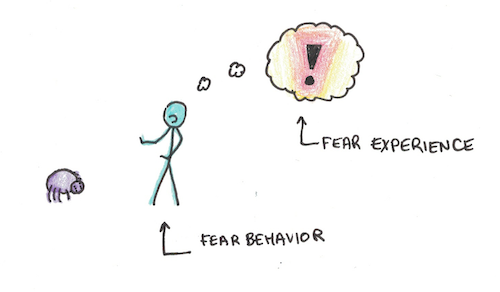
If you’ve followed any pop-sci articles on neuroscience, you’ve probably heard that the amygdala, an almond-shaped chunk of brain beneath the cortex, is the brain’s “fear center.” Scare someone (or a mouse in a laboratory) and the amygdala gets activated.
This has led to a wave of reporting that center our feelings of fear inside this little knob of brain tissue. This is unfortunate, in LeDoux’s estimation, because it’s not at all clear that signals processed by the amygdala are conscious at all.
Instead, LeDoux prefers the term “survival circuit” since, while it’s clear that the amygdala is involved in responding to threats, it’s not clear that activity here directly generates conscious feelings. Fear, as an experience, likely happens elsewhere, possibly in higher cortical areas of the brain that work with attention, thinking, imagining our futures and remembering our pasts.
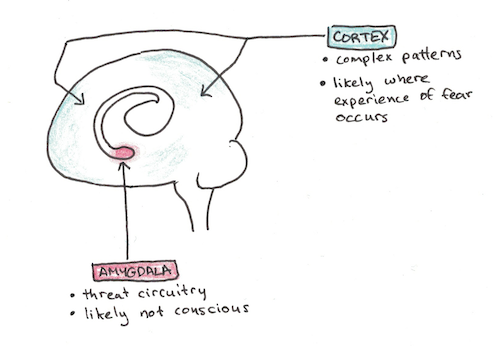
Put another way, if a threat falls in the amygdala, but there’s nobody there to feel it, does it actually make you fear? To LeDoux, anxiety you don’t consciously experience isn’t anxiety at all.
Side note: Fear, anxiety and worrying have different, technical meanings. Fear is the feeling associated with imminent danger. Anxiety is the feeling of uncertain threat. Worrying is anxious and repetitive thinking.
The Adaptive Unconscious and Fear
This division between nonconscious survival circuitry and conscious experience is reflected in more than just anxiety. In Strangers to Ourselves, psychologist Timothy Wilson argues that much of our mental operation exists outside of conscious thought.
The idea of an unconscious mind isn’t new, of course. Freud famously argued that our unconscious minds was a surreal dreamscape full of repressed desires about genital jealousy and wanting to romance our mothers.
This new picture of an unconscious, what Wilson calls the adaptive unconscious is much more mundane. The adaptive unconscious manages the business of living, often guiding our behavior without our awareness.
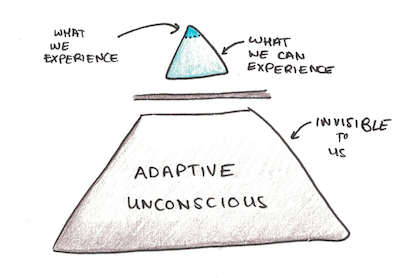
A classic demonstration of the adaptive unconscious are priming experiments. If you flash an image, and then quickly flash a kind of masking stimulus, subjects cannot consciously report what they saw. You can tell they can’t consciously report it, because when asked to guess about what it was, they do no better than chance.
Nonetheless, if that image is of a frightening face, unconscious threat circuits are mildly activated. Although you may not be able to consciously notice any difference, behavioral responses, such as muscle movements in the face, can be measured.
Experiments such as these suggest that a lot of sophisticated mental processing not only happens beneath our everyday awareness, it is completely inaccessible to our conscious mind.
Where Do Feelings of Anxiety Come From?
If threat circuitry isn’t directly conscious then, how does it impact our experience of anxiety which very much is conscious? In this case it’s likely that while the threat circuitry may not result in conscious experiences itself, it may trigger other mental processes which do cause us to worry.
One way this has been suggested is through bodily feedback. You experience some fearful stimulus, your amygdala and related areas react quickly and increases your heart rate. You feel your heart beating faster and your mind interprets this as fear.
While the bodily-feedback loop is a popular theory, LeDoux doubts it can be the total explanation. This feedback is probably just too slow for it to be the main pathway by which threat circuitry turns into conscious feelings.
Instead it might be that the amygdala triggers patterns in higher cortical areas which we can consciously experience as fear. In this case, the feelings we experience as anxiety are a downstream effect of the threat circuitry that we don’t experience directly.
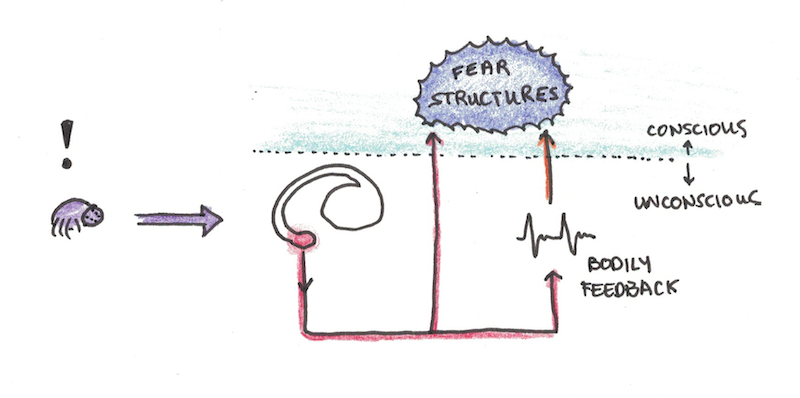
Still, the coupling between threat-circuitry and feelings of fear is not perfect. As already discussed, it’s possible to activate the threat-circuitry mildly without creating any conscious awareness (although behavioral responses are still observable). Conversely, it might also be possible to feel anxious even if there are no threat-response circuits firing at all.
The overall feeling of dread and constant worrying that characterizes a lot of anxiety may not need a trigger from threat circuits to become active. It may be a purely higher-order mental phenomenon. As a result, interventions that work by clamping down on threat-circuits may not help much in these cases.
Threat-Circuits and Anti-Anxiety Drugs
This bifurcation of systems: a nonconscious threat-response system as well as consciously felt fear, may have implications on our ability to treat anxiety.
For instance, LeDoux notes that drug companies haven’t always had great success at discovering anti-anxiety medications. When something does help with anxiety, it’s often discovered by accident, rather than design.
The separation of threat circuitry from conscious fear may partly explain why. Drugs are often selected by their ability to reduce fear-like behavior in laboratory animals. In doing so, however, they may be operating on nonconscious rather than conscious circuitry. This may not help as much when the goal is to treat conscious feelings of anxiety.
Exposure Therapy
This perspective might also have implications for improving therapy as well. Exposure therapy is a fairly successful therapy for combating anxiety. It works by exposing a patient to the object of their fears. When they experience fear but nothing bad follows, the fear will be a little less next time. LeDoux notes that around 70% of patients do get some help from exposure therapy.
Success isn’t perfect, however. Spontaneous recovery, whereby a previously extinguished fear returns back, seemingly without reason, can occur. Stress or trauma can also trigger remissions.
One reason for this seems to be that the memory for threat and the memory for safety are actually two distinct neural circuits. When you initial learn the threat, and then later extinguish the threat circuit through exposure, this doesn’t work by erasing the original memory, but by creating a second memory designed to suppress the first one. It’s as if, instead of erasing the fearful picture, you’ve merely painted over it with a fresh coat of paint, one that might get scratched off later by accident.
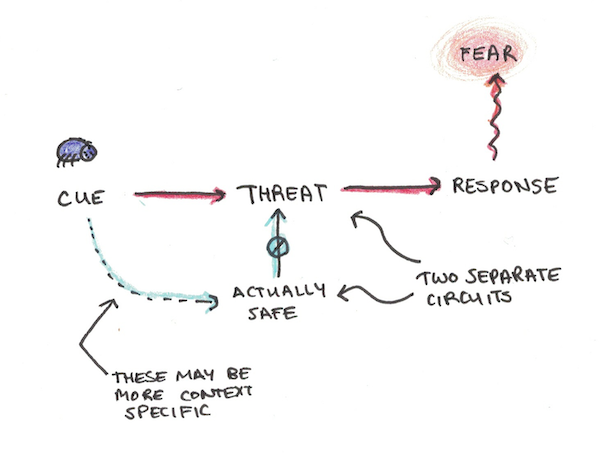
Interestingly this memory for safety that suppresses the original threat response may be more context-sensitive than the threat circuit itself. If you learn not to panic at a social gathering while with your friend, you may still panic when that person isn’t there to accompany you. Reducing this context-sensitivity requires many different exposures in varying situations, otherwise the experience may not transfer.
Side note: Context-specificity shows up in another context—learning. In Ultralearning, I reviewed research showing that the things we learn tend to be more specific and context-dependent than we expect. That this shows up in so many different contexts suggests it is a fairly general principle of how our brains work.
Why We Get Stuck in Anxiety
Anxiety can be self-reinforcing. Say you’re terrified of public speaking. You have an upcoming speech and you start feeling worse and worse about it. Finally, you come up with an excuse to avoid speaking. Now you feel better, whatever you were worried might happen can’t happen.
This actually creates a pattern of negative reinforcement. By removing something unpleasant (your anxious feelings) you reinforce the behavior that created it. Since what you fear never happens, the pattern to avoid what you fear gets stronger each time you feel anxious.
In nature, this pattern probably works fairly well. A rabbit that almost gets eaten while near a certain watering hole may never go back there. This may result in a little thirst, but it’s better than being eat by a crocodile.
The problem is that the avoidance strategy can work too well. It may be that the situation you’re afraid of is actually safe. By avoiding it, however, you never experience the disconfirming evidence that you don’t need to be afraid. In some cases, avoidance itself becomes worse than the thing you’re afraid of, as you take increasingly costly steps to avoid situations that might be scary.
Exposure therapy works to disable this feedback loop. Expose yourself to the thing you’re afraid of, and when nothing devastating happens, you diminish the fear response the next time. Repeat this and, eventually, the fear you experience will hopefully be mild enough so that it no longer interferes with your life.
While this is easiest to understand with phobias, there’s probably a similar avoidance reinforcement mechanism underlying a lot of more general anxiety and worrying. An imagined, fearful situation arises, and then you worry obsessively to find some possible escape. Since most catastrophic worries never actually happen, you’ve successfully avoided it and so the worrying behavior is reinforced.
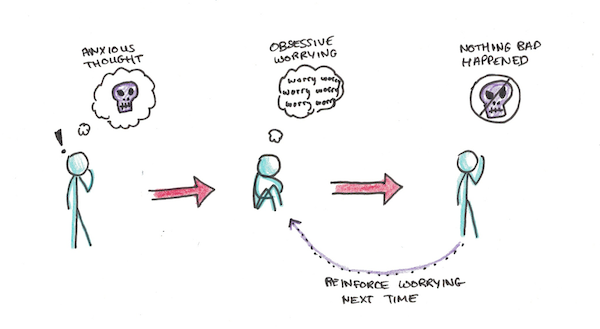
Extinguishing Fears and Changing Beliefs
Modern exposure therapy, however, is usually more than just direct exposure. It usually also involves cognitive therapy, which involves talking about your fears. The hope here is to make explicit some of your beliefs so you can start to question them. Our glossophobe might worry that if he bombs on stage, his boss will fire him. This may not be realistic, but unless it’s made explicit, it’s very difficult to evaluate this thought pattern.
According to LeDoux, these two different aspects work on the two different systems that contribute to feelings of anxiety. Exposure targets the threat-response circuitry, a largely nonconscious response. Only change someone’s beliefs, but leave the threat circuits untouched and someone may still be paralyzed with anxiety even though they know it’s completely irrational. For instance, you may “know” that standing in a glass elevator is totally safe, but be petrified looking down over the edge.
Similarly, if you only extinguish the threat circuit, higher-cognitive systems may reactivate it later. You hear about plane crash and all of a sudden your worries about flying resurface in ways you can’t control.
Implications of Anxious and Further Thoughts
The existence of parallel nonconscious and conscious states, and indeed, treating the two as somewhat separate systems that both contribute to behavior is an interesting insight I gleaned from the book.
In my own life, I often find myself talking through my problems, either by myself or with others. Sometimes this process can help. Writing down my plans, worries, goals and problems in a journal, or discussing it with a friend, can often lead to new insights or reveal flaws in my thinking that lead to breakthroughs.
In other cases, overthinking is exactly my problem. Thinking leads to more thinking which goes nowhere. Particularly in cases where I’m worried, this thinking becomes compulsive and difficult to control.
This book suggests that neglecting the nonconscious processing may be a major weakness here. Since many of the mental processes happen outside of awareness, they can’t really be fixed by thinking about them more. Alternative approaches, such as exposure, may be more effective in these cases because they work on the problem more directly.
This book also echos another neuroscience book I reviewed earlier, The Hungry Brain. In that book, sophisticated circuits control how much we eat which can explain why dieting is so hard. Like anxiety, these processes happen without our awareness, yet seem to exert incredible sway over our lives.
In some ways, the existence of these unseen processes makes things more difficult. How do you make decisions when many of your actions are decided by processes you have no access to? How do you effect change in your life when the causes of your behavior are often invisible? How do you know yourself when so much is not open to introspection?
These questions don’t have easy answers. But I hope by exploring these, we might uncover new tools to worry less.

 I'm a Wall Street Journal bestselling author, podcast host, computer programmer and an avid reader. Since 2006, I've published weekly essays on this website to help people like you learn and think better. My work has been featured in The New York Times, BBC, TEDx, Pocket, Business Insider and more. I don't promise I have all the answers, just a place to start.
I'm a Wall Street Journal bestselling author, podcast host, computer programmer and an avid reader. Since 2006, I've published weekly essays on this website to help people like you learn and think better. My work has been featured in The New York Times, BBC, TEDx, Pocket, Business Insider and more. I don't promise I have all the answers, just a place to start.